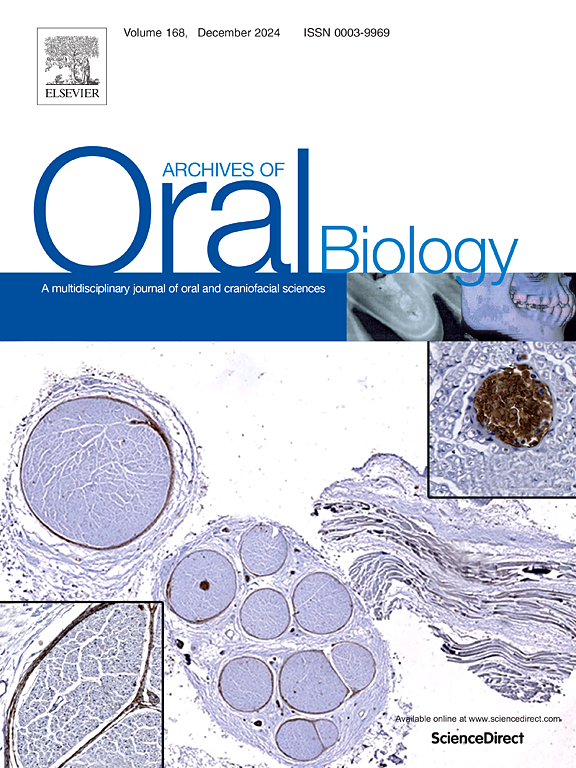Effect of experimental polymer-containing solutions in preventing caries-like lesions on enamel
IF 2.1
4区 医学
Q2 DENTISTRY, ORAL SURGERY & MEDICINE
引用次数: 0
Abstract
Objectives
To evaluate experimental solutions containing polymers (Chitosan: CHI, Sodium linear polyphosphate: LPP, Polyacrylic acid: PAA; and 2-methacryloyloxyethyl phosphorylcholine: MPC) isolated, associated or not with fluoride (F), stannous ions (Sn), or F+Sn in vitro against caries-like lesion in enamel.
Design
Bovine enamel sections were randomly allocated into 20 groups (n = 14): Distilled water (DIW, negative control), F: 220 ppm F-, Sn: 800 ppm Sn2+, F+Sn, and four polymers (0.5 % CHI, 2 % LPP, 0.1 % PAA, 2 % MPC) associated or not to F, Sn, or F+Sn. The single sections were individually subjected to a pH cycling: demineralization (3 h, 2 ×/d), experimental solution (1 min, 2 ×/d), and remineralization (overnight), for 5d. The enamel sections were analyzed using digital transverse microradiography (integrated mineral loss-ΔZ, and lesion depth-L). Data were analyzed using Kruskal-Wallis and Wilcoxon rank sum tests, with alpha= 0.05.
Results
When tested in isolation, LPP was the only polymer affording greater protection than DIW, while PAA enhanced ΔZ [median (Q1-Q3); vol%min× µm: 2530 (2070–3140) vs. 3710 (3410–3860) vs. 4375 (3820–4990) respectively; all p < 0.05]. None of the polymers could increase the protection provided by F [1430 (1340,1570), p = 0.084] or F+Sn [1515(1150–1940), p = 0.182)]. CHI [2525(1890–3210), p = 0.01] and LPP [3105 (2460–3250), p = 0.006] increase the protection offered by Sn [3500 (3350–3790)], but PAA enhanced ΔZ [4340 (3540–4820), p = 0.044]. For L data, there are no polymer effects compared to DIW [93.30(82.60–104.80), p = 0.177], F [78.25(70.40–90.30), p = 0.340] or F+Sn [73.05(54.60–81.00), p = 0.056]. Only MPC decrease the degree effect of Sn [113.10 (110.40–124.30) and 99.20(92.60, 105.80), p = 0.003].
Conclusions
LPP was the only polymer that protected enamel against demineralization when tested in isolation. However, none of the polymers could increase the protection offered by fluoride or fluoride plus stannous ions.
实验含聚合物溶液预防牙釉质龋样损伤的效果
目的评价壳聚糖:CHI、线性聚磷酸钠:LPP、聚丙烯酸:PAA、聚磷酸钠:LPP等聚合物的实验溶液。和2-甲基丙烯酰氧乙基磷酸胆碱(MPC)分离,与氟化物(F),锡离子(Sn)或F+Sn相关或不相关的体外抗牙釉质龋样病变。DesignBovine搪瓷部分被随机分配到20组(n = 14):蒸馏水(DIW -控制),F: 220 ppm F - Sn: 800 ppm Sn2 + F + Sn,和四个聚合物(0.5 %气,2 %垂直距离,0.1 % PAA, 2 % MPC)相关或不F, Sn或F + Sn。单个切片分别进行pH循环:脱矿(3 h, 2 ×/d),实验溶液(1 min, 2 ×/d)和再矿化(过夜),持续5d。牙釉质切片采用数字横向显微x线摄影(综合矿物质损失-ΔZ和病变深度- l)进行分析。数据分析采用Kruskal-Wallis和Wilcoxon秩和检验,alpha= 0.05。结果在分离测试中,LPP是唯一比DIW提供更强保护的聚合物,而PAA增强ΔZ[中位数(Q1-Q3)];体积% minx µm: 2530 (2070-3140) vs. 3710 (3410-3860) vs. 4375 (3820-4990);所有p & lt; 0.05]。这些聚合物都不能增加F [1430 (1340,1570), p = 0.084]或F+Sn [1515(1150-1940), p = 0.182]所提供的保护。CHI [2525(1890-3210), p = 0.01]和LPP [3105 (2460-3250), p = 0.006]增强了Sn[3500(3350-3790)]提供的保护,而PAA增强了ΔZ [4340 (3540-4820), p = 0.044]。对于L数据,与DIW [93.30(82.60-104.80), p = 0.177],F [78.25(70.40-90.30), p = 0.340]或F+Sn [73.05(54.60-81.00), p = 0.056]相比,没有聚合物效应。只有MPC降低了Sn的度效应[113.10(110.40-124.30)和99.20(92.60,105.80),p = 0.003]。结论slpp是唯一对牙釉质有脱矿保护作用的聚合物。然而,这些聚合物都不能增加氟化物或氟化物加锡离子提供的保护。
本文章由计算机程序翻译,如有差异,请以英文原文为准。
求助全文
约1分钟内获得全文
求助全文
来源期刊

Archives of oral biology
医学-牙科与口腔外科
CiteScore
5.10
自引率
3.30%
发文量
177
审稿时长
26 days
期刊介绍:
Archives of Oral Biology is an international journal which aims to publish papers of the highest scientific quality in the oral and craniofacial sciences. The journal is particularly interested in research which advances knowledge in the mechanisms of craniofacial development and disease, including:
Cell and molecular biology
Molecular genetics
Immunology
Pathogenesis
Cellular microbiology
Embryology
Syndromology
Forensic dentistry
 求助内容:
求助内容: 应助结果提醒方式:
应助结果提醒方式:


